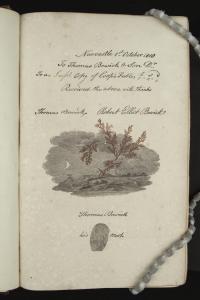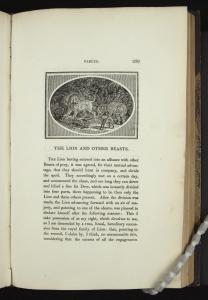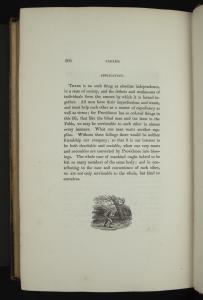

The Fables of Æesop, and others / With designs on wood, by Thomas Bewick
1. The complaint, and the consolation; or, Night thoughts
2. The Fables of Æesop, and others / With designs on wood, by Thomas Bewick
5. News from nowhere: or, An epoch of rest, being some chapters from Utopian romance
6. The nature of Gothic, a chapter of the stones of Venice
7. Daphnis and Chloe: a most sweet abd pleasant pastoral romance for young ladies
8. The Sphinx
10. Credo
14. Bible.Old Testament. Song of Solomon.
16. Kem byt’? / V. Mai︠a︡kovskiĭ ; ris. N. Shifrin.
17. The ghost in the underblows
19. Bateau ivre
UCLA Call Number: PA3855.E5 B4 1818

The receipt functions as a note of authenticity for buyers. The combination between a sprig of red seaweed and a landscape creates surreal imagery. This double presswork, a copper and a wood engraving, causes the place of the red seaweed to vary from book by book, resulting in the uniqueness of each volume. The image of the thumb–print or fingerprint first appeared in British Birds in 1797 and in Bewick’s Vignettes in 1827. The one published originally in British Birds was paired with a grave scene, symbolizing the frailty of human life.

The Fables of Æesop, and others / With designs on wood, by Thomas Bewick.
The very fact that the visual image depicting a lion, a fox, and a tiger does not seem very lively hints at the rigid and static political landscape where privileges of the power are not shared with others. Fables of Aesop, and others by Bewick is more bent toward the political disposition of the author rather than toward moral instructions. The setting and the position of each animal in the image convey a realistic sense of the animal world as well as the human world, as both animals and humans desire absolute power. This image is the reflection of Bewick as he observed the failing political systems in England. It is very clever for Bewick to choose a fable as the vehicle to express his political stance. The book fulfills its double purpose as moral instruction and as political satire.

The Fables of Æesop, and others / With designs on wood, by Thomas Bewick.
Historically, vignettes or tailpieces are not intended to convey the ideas in the text. They serve as ornaments, often in the form of shields, pergolas, flowers, and shells or imaginative mechanisms supporting the main motif. Thomas Bewick employed them as a central motif. Dickens once compared Bewick's vignettes to the camera of a large picture in his own magazine,All the Year Round.
Creator: Bewick, Thomas
Publisher: Newscastle
Publication Place: London
Date of Publication: 1818
Dimensions 26 x 16 cm
Technologies of Production wood engraving
Physical Description:
The book feels heavy in the hand and is fairly in good condition with some signs of wear around the edges. The cover is made of hardboard and brown leather. The title is inscribed on the spine in gold. This book is the first edition that disappointed subscribers, including Bewick himself, with its poor printing quality due to weather. Texts are in all black and plain.
Provenance:
This sample copy was published on Oct 25, 1817, for the proprietor, Anthony Molteno & Paul Colnaghiat, Pall Mall, & Colnaghi, Cockspur St., London. John Humfrey from Wroxham purchased the copy in 1820 and it was [later sold to C.K. Ogden at £10.10.]
Condition:
Old boards, a few minor spots, a crease to the final leaf, and stains.
Additional Info:
Nicholson’s work was executed in 1816 by Thomas Rason. The portrait of Bewick was engraved by John Burnett and painted by James Ramsay.
Interpretation:
Born into a family with generations of business in the colliery, Thomas Bewick developed strong attachment to nature and to its community while he achieved his reputation as a master of wood engraving, an imaginative artist, and a humane moralist. [Footnote 1] From an early age, Bewick was involved with farm labor, ran around wastes and vast land and became intimate with landscape scenes and livestock. These close observances of animals and proximity to nature profoundly enriched his imagination. His artistic nature was cultivated and inspired by his native environment. While Bewick started working as an apprentice to Ralph Beilby at the age of fourteen, Aesop, the Greek slave and author of Fables, served as a strong influence on Bewick’s development of his artistic skills for book illustration and in his dedication to moral education. His adoration for Aesop can be observed in the fact that Bewick possessed more than 13 different editions or copies for Aesop’s fables. [Footnote 2] As seen in Bewick’s memoir, he had intended to publish a book of fables during a convalescence. “I could not however help regretting that I had not published a Book, similar to Croxall’s Esops Fables.” [Footnote 3] Bewick identified himself with the ideas of Croxall, advocating for civil liberties. This educational piece fits in modernism since the vignettes and tailpieces, often supplementary to the literary texts in the book, occupy the equal space to the text, contrary to tradition, and, in fact, even echo its moral messages louder than the texts. This reverse of the traditional role between text and image is innovative. Most of all, Bewick pioneered the integration of word and image. He was a unique artist “who invented, drew, and engraved his own designs in wood.” [Footnote 3]
References
1. Diana Donald, The Art of Thomas Bewick, (London: Reaktion Books). 2013.
2. Bewick Studies; Essays in Celebration of the 250th Anniversary of the Birth of Thomas Bewick 1753‐1828. (London: The British Library). 2003. p.70.
3. Diana Donald, The Art of Thomas Bewick, (London: Reaktion Books). 2013.
The overall tone of the book is didactic and rather philosophical as it brings up topics such as death, social ills, and human misfortune. Deploring social class conflict and political disillusion, Bewick reinterprets and elaborates the Fables of Aesop with a reference to the concurrent issues in England. Bewick’s Fables of Aesop, with its lengthy “Application,” intends to sow the seeds of morality and patriotism from an early age among the youth.
Contributor: Hong,Jungeun